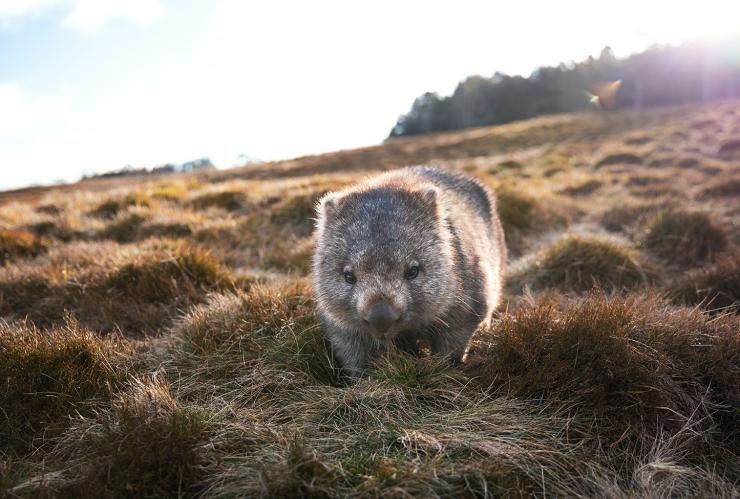
Cape Hillsborough National Park, Queensland © Tourism and Events Queensland
Guide to Australia’s animals
From charismatic kangaroos to enigmatic emus, most of Australia’s wildlife is endemic – found nowhere else on the planet – and an animal encounter is a highlight of any visit.
By Allie Metz & Carolyn Beasley
A long period of separation from the rest of the world has blessed Australia with its utterly unique fauna. Cut off from other continents for about 30 million years, our wildlife has evolved to suit the conditions here.
Here's a breakdown of our incredibly unique animals and where you can find them.
- What are Australia's iconic animals?
- Where can I have a close animal encounter?
- Where can I see Australian animals in the wild?
- What's the best time of year to see Aussie animals?
- How can I experience Australian wildlife responsibly?
- Which Australian animals are endangered?
- Are Australian animals dangerous?
What are Australia's iconic animals?

Wombat, Cradle Mountain, Tasmania © Tourism Australia/Daniel Tran
With animals so unmistakable, it’s little wonder that some have come to represent the unique country itself. Don’t miss meeting at least some of these during your visit.
Wombat: Australia’s second largest marsupial, these rotund grass-munchers are more agile than they appear with top speeds of up to 40 kilometres (25 miles) per hour!
Where can I have a close encounter?

Devils @ Cradle, Cradle Mountain National Park, Tasmania © Laura Helle
If seeing a Tasmanian devil in the snow or getting close to a koala is high on your bucket list, visiting one of our incredible zoos or wildlife sanctuaries is an excellent way to safely get up close and personal with our animal ambassadors.
Zoos: If too many animals are never enough, or perhaps you’re just short on time, a zoo is a great option. In Australia, they can be found in every major city as well as many regional areas.
Sanctuaries: Wildlife parks house many free-ranging native animals, where visitors can interact with wildlife in a semi-natural environment. Wildlife sanctuaries usually have a focus on rehabilitation or aim to protect certain threatened species. Many are also home to wildlife hospitals helping injured animals.
Where can I see Australian animals in the wild?

Kangaroos, Pebbly Beach, Murramarang National Park, New South Wales © Tourism Australia
There's really nothing more exciting than spotting Australia's iconic animals in the wild. Luckily, it's not difficult - if you know where to look. Here's a breakdown of our major habitats and which animals you can expect to find there.
Forests and grasslands: Many of Australia’s best-loved animals call our forests or grassy plains home and, lucky for us, these habitats are often located just a short distance from our major cities. You'll have a good chance of spotting kangaroos, wallabies, koalas, wombats, echidnas and even platypuses.
Our coral reefs: The Great Barrier Reef is home to 1,625 known fish species and six of the world’s seven types of sea turtle. You can also find whales, harmless reef sharks, rays, dugongs, hard and soft coral, mollusks and more. Equally beautiful is the Ningaloo Reef where whales, dolphins, dugongs, manta rays, huge cod, turtles and whale sharks live in abundance.
What is the best time of year to see Australian animals?

Koala joey with mother, Australia Zoo, Beerwah, Queensland © Ben Beaden / Australia Zoo
If a wildlife encounter is high on your must-do list, be sure to explore the unique animal events that come with each season. From swimming with whale sharks in autumn and bird watching in winter, to witnessing baby koalas pop out of their pouch in spring and turtle hatchlings head to sea in summer - there's something spectacular to witness at every time of year.
How can I experience Australian wildlife responsibly?

Worn Gundidj @ Tower Hill, Victoria © Tourism Australia
With stringent animal welfare guidelines in place for all tour operators, it's easy to have a wildlife encounter that is rewarding and positive - for both you and our precious animals. Follow our simple guidelines to experience wildlife responsibly and be sure to read our top tips for spotting wildlife.
For an immersive experience that focuses on conservation activities, the tour operators that make up Australian Wildlife Journeys offer unforgettable wildlife encounters. Small group sizes, expert interpretive guiding and a commitment to protecting Australia's unique fauna mean your experience will be meaningful in a multitude of ways.
Australia's Indigenous communities share a strong bond with the land and its animals. Animals are cultural Totems, food sources, bearers of wisdom and guides to the seasons. Learning about native wildlife through the lens of an Aboriginal guide adds a layer of understanding that is unobtainable in any other way. Discover Aboriginal Experiences offers unique wildlife tours that showcase the cultural connection to nature.
What Australian animals are endangered?

The Bilby Experience, Charleville, Queensland © Save the Bilby Fund
Population decline of a species can be attributed to habitat loss or degradation, invasive species, natural disasters and climate change - just to name a few.
Some of our vulnerable, endangered or critically endangered mammals include the northern hairy-nosed wombat, several species of potoroo and rock wallaby, the western ringtail possum, several species of quoll, the bilby, koala, Australian sea lion, bandicoot and some species of whale.
Bird species under threat include several species of albatross and parrot, Cape Barren Goose, and the grey falcon. Playing a critical role in the ecosystem and no less important than our birds and mammals, Australia is also home to threatened species of insect, fish and reptile.
While this list is far from exhaustive, you can learn more about threatened species in Australia and what some incredible organisations are doing to help change the trajectory of declining species. When booking your trip, consider your ecological footprint and get involved in conservation initiatives and rewarding volunteer programs that will leave the environment better than how you found it.
Are Australia's animals dangerous?

Thorny Devil, Uluru-Kata Tjuta National Park, Northern Territory © Tourism Australia
There are many myths around dangerous animals Down Under, but rest assured Australia is a safe place to experience nature and wildlife. In fact, it's unlikely you will even see a dangerous animal during your visit. However, when interacting with any animal - even the cute and cuddly ones - it's important to exercise caution. Get the facts about dangerous animals in Australia before you travel to ensure you get the most out of your adventure.































































































































